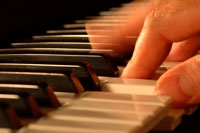 One trick that is essential for musicians is knowing how to
transpose chords. Transposing is the process of changing a section of music to
another key. Sometimes this is done to make it more comfortable for the singer,
sometimes it is done for ease of playability, and sometimes it is just for
personal tone preference.
One trick that is essential for musicians is knowing how to
transpose chords. Transposing is the process of changing a section of music to
another key. Sometimes this is done to make it more comfortable for the singer,
sometimes it is done for ease of playability, and sometimes it is just for
personal tone preference.
As with a lot of things in music, there is more than one way
to do this. The first way is to count the distance from the starting key to the
destination key. This is easier than the alternative at first, but it is time
consuming and not necessary once you learn the other way. The other way is to
convert everything to numbers. While this soundsharder and more time consuming,
it is eventually more efficient.
We'll start with the counting. Let's say that you are
playing a song in C and your friend wants to play it in A. You first pick
whether you want to transpose up or down. (Usually one way or the other is
easier depending on the instrument and what tone range you're starting with.)
If you aren't sure, just pick the one that seems closer for now. Count from the
starting key (C) to the destination key (A) in halfsteps. Let's say we are
going down. C -> B -> Bb -> A. It is down 3 halfsteps or 1 1/2 whole
steps. Now you take every chord in the song, and move it down 1 1/2 steps. So
if your song is like this:
C F C G
C Dm G C
We take each of these and move them all down 1 1/2 steps.
A D A E
A Bm E A
This wasn't too hard and it didn't take too long, but what
if the song changes keys the second time through? Then we have to do this whole
process over again. This is why it's helpful to know how to transpose chords
the other way.
This time we're going to take that same song and convert it
to numbers. To do this, you have to have at least some knowledge of scales.
We'll take the song in its original key (C) and using that scale, we'll assign
numbers to those notes:
C F C G
C Dm G C
C D E F G A B C
1 2 3 4 5 6 7 1
I IV I V
I ii V I
Now that we have the song converted to numbers we can put it
in any key, as long as we know that scale. So to convert it to A we take an A
scale and assign numbers to it:
A B C# D E F# G# A
1 2 3 4 5 6 7 1
And we fill in the numbers in the song with the numbers in
the scale:
A D A E
A Bm E A
Now let's say the song changes to B the second time through:
B C# D# E F# G# A# B
1 2 3 4 5 6 7 1
If you already know a B scale, you just fill in the numbers
from the scale:
B E B F#
B C#m F# B
And now you know how to transpose chords with numbers. No
counting halfsteps is required. Once you have the song converted to numbers,
they are universal and can be applied to any key. The more you use this process
and the more scales you memorize, the easier this gets. Soon it will be instant
and thoughtless. Just remember to start with the scale of the key you want to
play in, and fill in the numbers.
Feel free to start out with the first method, just to get
used to transposing, but remember that it will always be slower in the end.
Comments
Post a Comment